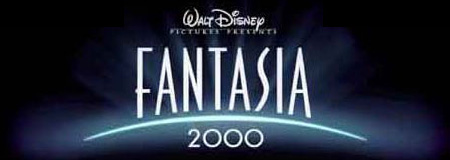
Information * Segments * Roy Disney interview * Interesting Facts * Making "Rhapsody"

Information * Segments * Roy Disney interview * Interesting Facts * Making "Rhapsody"
![]() Running Time: 85 minutes
Running Time: 85 minutes
Release date: January
1, 2000 (4-month IMAX run) & June 16, 2000 (4-week 35mm run)
![]() Featuring:
Bette Midler, James Earl Jones, Quincy Jones, Angela Lansbury, Steve Martin
(stay after the end credits for a tiny surprise!) and Leopold Stokowski
Featuring:
Bette Midler, James Earl Jones, Quincy Jones, Angela Lansbury, Steve Martin
(stay after the end credits for a tiny surprise!) and Leopold Stokowski
![]() Budget:
$80 million
Budget:
$80 million
U.S. Opening Weekend: $2.239
million over 54 screens (IMAX), $2.911 million over 1,313 screens (wide)
Box-Office: $50 million
in the U.S. during its 4-month IMAX run in 53 theatres, $64.5 million worldwide
in 75 theatres only! $10.507 million in 1,313 regular multiplexes, $90.7
million worldwide
 |
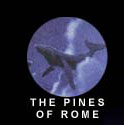 |
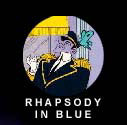 |
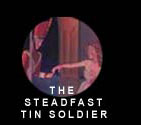 |
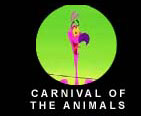 |
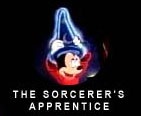 |
 |
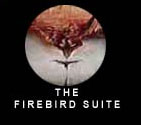 |
![]() In
late 1999, Disney Magazine caught up with the film's executive producer,
Roy Disney -Walt's nephew- to discuss his pet project.
In
late 1999, Disney Magazine caught up with the film's executive producer,
Roy Disney -Walt's nephew- to discuss his pet project.
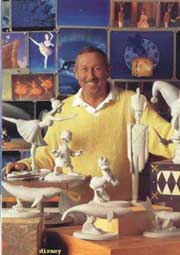 Let's
go back to when you decided to do Fantasia 2000. Did you think of it as
a sequel or a continuation?
Let's
go back to when you decided to do Fantasia 2000. Did you think of it as
a sequel or a continuation?
Roy Disney: The title for quite a while was Fantasia Continued because the notion was of a continuation. The very first version was, well, let's keep half of the old one and make half a (new) movie - which might have been what Walt would have done. Then wait a few years and make four or five more pieces...
When did you decide to do Fantasia 2000? Was it when Fantasia was about to come out on video?
Roy Disney: Well, with me, it was way earlier than that. I always love Fantasia. Because of the sort of wondrous variety that it brought, it was like a sampler: This one's a cherry cream, that one's a chocolate-covered nut, or something. I really loved that idea of variety. Dad (Roy O. Disney) came home one time not long after the film was out, and he said, "The next piece Walt wants to do is 'The Flight of the Bumblebee,' and he want to fly the bee all the way around the room is stereo!" And that stuck with me, that notion - that there was the potential for this thing to continue.
But more recently...
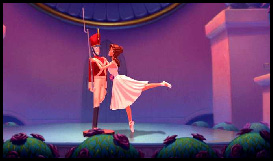 Roy
Disney: At some point Michael (Eisner) asked me what's my favorite
movie, and I said, "Fantasia".
And be the way, I said, here was Walt's concept for it. I saw his eyes
kind of light up. I'd always though, well, great idea but it'll never happen.
At that moment, we hadn't made "The
Little Mermaid" or "Beauty
and the Beast". I actually had, even then, two or three pieces of music
that I thought would be wonderful, "Pines of Rome" wound up in the show.
Roy
Disney: At some point Michael (Eisner) asked me what's my favorite
movie, and I said, "Fantasia".
And be the way, I said, here was Walt's concept for it. I saw his eyes
kind of light up. I'd always though, well, great idea but it'll never happen.
At that moment, we hadn't made "The
Little Mermaid" or "Beauty
and the Beast". I actually had, even then, two or three pieces of music
that I thought would be wonderful, "Pines of Rome" wound up in the show.
What were the criteria for choosing the music?
Roy Disney: It had to be description music, it had to be something that had the sense of a story progression... and it also had to be just appealing to use as music.
Was it fun picking the music?
Roy Disney: Oh, yeah, I've always had an
affection for classical music, which goes back again to Walt and my dad
helping Buffy Chandler out when she was trying to get the Hollywood Bowl
reenergized (in the 1940s and 1950s). And  they
both wound up with good box seats, which I inherited from Dad. (My wife)
Patty and I were among the people who invented the notion of picnics before
the music stated, I'd run home at six o'clock and we'd get up there as
fast as we could, lay out a picnic basket and listen to the music, and
go... oh, wow!
they
both wound up with good box seats, which I inherited from Dad. (My wife)
Patty and I were among the people who invented the notion of picnics before
the music stated, I'd run home at six o'clock and we'd get up there as
fast as we could, lay out a picnic basket and listen to the music, and
go... oh, wow!
How daunting was this assignment, knowing that you're taking Walt's great masterpiece and re-creating it?
Roy Disney: The first thing that goes through
your mind is that this is pretty audacious, to (update) what a lot of people
say s a masterpiece, and I think so, too. But that's not what we're doing.
We're doing the thing that Walt wanted to do in the first place, which
is to go on with the idea. There's some quote where Walt says, "It's the
best idea I ever had I could never improve on it, I can only add to it
or embellish it," or something like that. So from that point, someone's
(bound to) say "how dare you" to us. I'm sure I'll be hurt, but you gotta
move on. What if you didn't do it, what if you stood around and said, "Look
at this wonderful idea," and never did it? That's a dumb way to live your
life.
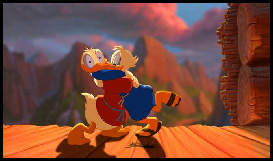
How do you feel about giving Donald equal
time with Mickey? Donald's really the hero of "Pomp and Circumstance.?
Roy Disney: Oh, I love that idea. He always was second banana, but not by much. It was great to be able to site down and say, "Okay, we can really animate Donald the way we remember him." The other fun thing was that you don't get any dialogue for him, so you don't have to worry about whether you can understand him or not.
How would you describe your creative role in the whole process?
Roy Disney: I dunno, ask somebody else.
I guess I'm... the Walt thing about the little bee going around pollinating,
I thing I kind of played that part... I thank Michael for trusting me.
And I really am enormously happy. I think it's really gonna blow people
away.
![]() Larry
Pontius revealed to Jim
Hill Media that he developed an abandoned version of Fantasia II
in the 1970s. "For whatever its worth, my idea for Fantasia II included
quadraphonic sound and songs from the 'classic' American music composed
since the original. It would have included everything from West Side Story
to the Beatles, with Elmer Bernstein conducting the New York Philharmonic
Orchestra. Somewhere inside the idea was the thought that we could get
both adults and kids into the movie and help a little in getting them each
to understand the other's choice in music. Again, Bob Moore did a poster--featuring
an alligator playing a cello."
Larry
Pontius revealed to Jim
Hill Media that he developed an abandoned version of Fantasia II
in the 1970s. "For whatever its worth, my idea for Fantasia II included
quadraphonic sound and songs from the 'classic' American music composed
since the original. It would have included everything from West Side Story
to the Beatles, with Elmer Bernstein conducting the New York Philharmonic
Orchestra. Somewhere inside the idea was the thought that we could get
both adults and kids into the movie and help a little in getting them each
to understand the other's choice in music. Again, Bob Moore did a poster--featuring
an alligator playing a cello."
![]() Early
test screenings rated the 90-minute version of the film "too long and slow-moving".
Roy Disney reluctantly agreed to cut 2 segments: Tchaikovsky's
Nutcracker Suite from the original Fantasia, and Ponchielli's
Dance
of the Hours. The line-up was changed at the last possible second,
and all the press materials, posters, CD artwork, had to be sent back to
the Art Department so all Nutcracker elements could be removed.
Early
test screenings rated the 90-minute version of the film "too long and slow-moving".
Roy Disney reluctantly agreed to cut 2 segments: Tchaikovsky's
Nutcracker Suite from the original Fantasia, and Ponchielli's
Dance
of the Hours. The line-up was changed at the last possible second,
and all the press materials, posters, CD artwork, had to be sent back to
the Art Department so all Nutcracker elements could be removed.
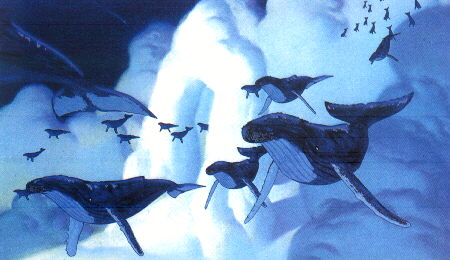
![]() In
the Pines of Rome sequence of
Fantasia 2000, one of the icebergs
bears a suspicious resemblance to the Matterhorn at Disneyland.
In
the Pines of Rome sequence of
Fantasia 2000, one of the icebergs
bears a suspicious resemblance to the Matterhorn at Disneyland.
![]() Eric
Goldberg directed the segments Rhapsody in Blue, and you can tell!
As the out-of-work man is leaving the diner at the beginning of the segment,
Eric Goldberg's name can be seen listed on the menu posted on the wall;
the hotel/high-rise apartment that the little girl and the hen-pecked husband
leave from is called "The Goldberg"; hidden directly above the revolving
door of "The Goldberg" is Eric Goldberg's wife's name: Kathleen!
Eric
Goldberg directed the segments Rhapsody in Blue, and you can tell!
As the out-of-work man is leaving the diner at the beginning of the segment,
Eric Goldberg's name can be seen listed on the menu posted on the wall;
the hotel/high-rise apartment that the little girl and the hen-pecked husband
leave from is called "The Goldberg"; hidden directly above the revolving
door of "The Goldberg" is Eric Goldberg's wife's name: Kathleen!
![]() Goldberg,
a stickler for detail, made sure that the pianist's fingers hit the correct
keys!
Goldberg,
a stickler for detail, made sure that the pianist's fingers hit the correct
keys!
![]() The hen-pecked
husband character in the Rhapsody in Blue segment is based (looks-wise,
anyway) on John Culhane, the man who wrote the book (literally!) on Fantasia
and Fantasia 2000. He is also the man animators based Medusa's henchman
on in The Rescuers -you can even
see the resemblance between those two characters!
The hen-pecked
husband character in the Rhapsody in Blue segment is based (looks-wise,
anyway) on John Culhane, the man who wrote the book (literally!) on Fantasia
and Fantasia 2000. He is also the man animators based Medusa's henchman
on in The Rescuers -you can even
see the resemblance between those two characters!

![]() For
Rhapsody
in Blue, Eric Goldberg was inspired by the artist style of Al Hirshfeld,
caricaturist -just like he was when he animated the Genie in
Aladdin.
In honor of Hirshfeld's tradition of placing hidden Nina's in his art -Nina
is his daughter's name-, the art team placed hidden Nina's in the piece.
One is found at the bottom of a toothpaste tube and the others are disguised
top and bottom of the domineering wife's fur coat. There is
a hidden "Nina" in the list of items on the bill at the pet store in the
Rhapsody
in Blue segment.
For
Rhapsody
in Blue, Eric Goldberg was inspired by the artist style of Al Hirshfeld,
caricaturist -just like he was when he animated the Genie in
Aladdin.
In honor of Hirshfeld's tradition of placing hidden Nina's in his art -Nina
is his daughter's name-, the art team placed hidden Nina's in the piece.
One is found at the bottom of a toothpaste tube and the others are disguised
top and bottom of the domineering wife's fur coat. There is
a hidden "Nina" in the list of items on the bill at the pet store in the
Rhapsody
in Blue segment.
![]() More than
100 names of Fantasia artists are hidden in the city's background landscape.
When you watch the Rhapsody in Blue section of Fantasia 2000
very closely, you will notice howmany of the names of the artists have
been used in the scenery. For example: the name Doug is used over 20 times
at the swing-door, in the doorpost... and the name Jessica is on one of
the vases next to the door... Also watch the menu's in the little restaurant...
and the windows of all the shops... hundreds of names will appear if you
watch carefully!
More than
100 names of Fantasia artists are hidden in the city's background landscape.
When you watch the Rhapsody in Blue section of Fantasia 2000
very closely, you will notice howmany of the names of the artists have
been used in the scenery. For example: the name Doug is used over 20 times
at the swing-door, in the doorpost... and the name Jessica is on one of
the vases next to the door... Also watch the menu's in the little restaurant...
and the windows of all the shops... hundreds of names will appear if you
watch carefully!
![]() During James Earl Jones's introduction to Carnival of the Animals,
a small model of The Lion King's
Mufasa (for whom Jones supplied the voice) appears on a table behind him.
During James Earl Jones's introduction to Carnival of the Animals,
a small model of The Lion King's
Mufasa (for whom Jones supplied the voice) appears on a table behind him.
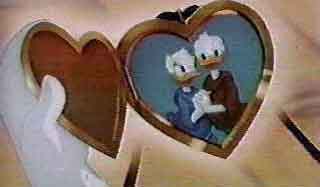
![]() The flamingo playing with the yoyo was inspired by Mike Gabriel's use of
a yoyo to shrug off boardome while filming flamingos at zoos to capture
their motion.
The flamingo playing with the yoyo was inspired by Mike Gabriel's use of
a yoyo to shrug off boardome while filming flamingos at zoos to capture
their motion.
![]() In the Pomp and Circumstance sequence, Noah's ark is shaped like
Donald Duck's body.
In the Pomp and Circumstance sequence, Noah's ark is shaped like
Donald Duck's body.
![]() Fantasia 2000
became
the fastest-grossing large-format film in industry history. It earned
$2.6M in 54 IMAX screens when it first opened on January 1st, 2000 -but
made only $2.8M when it opened in 1,313 normal theaters all across North
America on June 16th of that same year.
Fantasia 2000
became
the fastest-grossing large-format film in industry history. It earned
$2.6M in 54 IMAX screens when it first opened on January 1st, 2000 -but
made only $2.8M when it opened in 1,313 normal theaters all across North
America on June 16th of that same year.
![]() In June 2000, Roy Disney confirmed that there were plans for another
Fantasia,
at the time set for a 2006 release (though word is that the film will either
be "fast-tracked" to meet a 2005 deadline, or paced down to be released
in 2010 since Eisner wants the film to hit a "title friendly" numbered
date!). James Levine was reinstated for the occasion to conduct new
pieces of music, and had already finished conducting a modern piece of
music based on an African rhythm: it involves a group of children
in a small township in Africa, who watch a feather float through the air.
Seeing this, the children get an idea and make kites to fly in the air.
Adapting this modern piece of music continues the tradition of Fantasia
as an experiment and vehicle to explore different cultural music.
In June 2000, Roy Disney confirmed that there were plans for another
Fantasia,
at the time set for a 2006 release (though word is that the film will either
be "fast-tracked" to meet a 2005 deadline, or paced down to be released
in 2010 since Eisner wants the film to hit a "title friendly" numbered
date!). James Levine was reinstated for the occasion to conduct new
pieces of music, and had already finished conducting a modern piece of
music based on an African rhythm: it involves a group of children
in a small township in Africa, who watch a feather float through the air.
Seeing this, the children get an idea and make kites to fly in the air.
Adapting this modern piece of music continues the tradition of Fantasia
as an experiment and vehicle to explore different cultural music.
Taken from the December 1999 article by Charles
Solomon, "Rhapsody in Blue: Fantasia 2000's Jewel in the Crown"
published by Animation
World Magazine
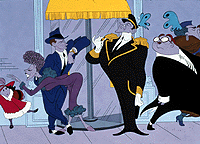 The
most charming piece in Walt Disney Feature Animation's Fantasia 2000
is the stylish portrait of New York in its palmier days, set to George
Gershwin's 1924 "Rhapsody in Blue" and drawn in the style of caricaturist
Al Hirschfeld. The segment was directed by Eric Goldberg, who animated
the mercurial Genie in Aladdin; the art director was Susan Goldberg --
a rare example of a husband and wife creative team in animation.
The
most charming piece in Walt Disney Feature Animation's Fantasia 2000
is the stylish portrait of New York in its palmier days, set to George
Gershwin's 1924 "Rhapsody in Blue" and drawn in the style of caricaturist
Al Hirschfeld. The segment was directed by Eric Goldberg, who animated
the mercurial Genie in Aladdin; the art director was Susan Goldberg --
a rare example of a husband and wife creative team in animation.
"Rhapsody" follows four restless individuals through `30s Gotham. Rachel, a tiny girl, is weary of being dragged to endless private lessons by her governess; John longs to be free of his battle-ax wife and her spoiled lapdog. Sad-eyed Joe searches for a job, while Duke, an African-American construction worker, dreams of being a jazz drummer. A series of coincidences and the magic of the city make each of their dreams come true.
"New York embraces all types of people, and they're all walking the
streets at the same time," explains Eric. "How people of such diverse backgrounds
affect one another when they live so closely together really interested
me. We devised a story where they all help each other achieve their goals
-- without ever realizing that they're helping one another. `Rhapsody'
has always been one of my favorite pieces of classical music, and the combination
of Hirschfeld and Gershwin to evoke 1930's New York seemed like a real
winner."
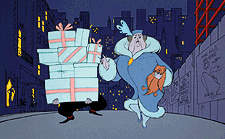
Eric got the idea for "Rhapsody" when he was finishing work on Aladdin.
He approached Hirschfeld, who gave his blessings to the project. After
completing the "Carnival of the Animals" segment of Fantasia, on
which he and Susan also collaborated, Eric storyboarded the entire film.
When production halted on the feature Kingdom
in the Sun to rework its story, the Goldbergs pitched "Rhapsody"
to Disney Feature Animation President Tom Schumacher as a down time project
for the Kingdom artists. They received the go-ahead to make it as a short.
Hirschfeld's celebrated caricatures display a marvelous elegance and economy of line. But they're static works that show their subjects from a single perspective: "Rhapsody" required the animators to move the characters in three dimensions while maintaining his polished minimalism.
"I animated the scene where Gershwin himself plays the piano, so I had
to deal with making the figure look like a Hirschfeld drawing turning in
three dimensions without losing any of the design qualities," says Eric.
"We shot live-action of Ralph Grierson, who plays the piano in the piece,
then Kent Holliday and I sat down together and determined which fingers
hit which keys on which notes. But not only did the fingers have to hit
the right keys at the right time, they had to look like Hirschfeld fingers
-- I had to curl one up or crack a knuckle in a way that resembles a Hirschfeld
drawing. It was fraught with challenges, but it was darned fun to do."
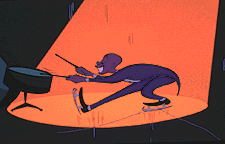
It's obvious that the other animators also enjoyed making "Rhapsody."
There's an almost tangible exuberance to the animation. The characters
move with a grace that is markedly freer than their counterparts in the
recent Disney features.
"We had touched on Hirschfeld's style in Aladdin, but we went a lot further in this film, trying to do his line," recalls animator Andreas Deja. "The fascinating thing about Hirschfeld's figures is the economy and fluidity of that line: one S-curve can describe a whole body; ordinarily in animation, we break a figure down into a series of body parts that move in individual ways. When you're dealing with a Hirschfeld design, everything follows one main rhythm. It forces you to think very clearly and directly, and in a more graphic way."
Preserving that elegant line was a major concern: "Emily Jiuliano, who
was our co-head of clean-up, was our `Keeper of the Line,'" says Eric.
"She made sure that everybody got a Hirschfeld line on the screen with
a beautiful thick and thin. She was quality control and artistic control,
and did a spectacular job." But "Rhapsody" is more than black lines, however
graceful. The characters move through a brightly colored city that echoes
their various moods. Its bold colors and graphic backgrounds recall the
more stylish UPA films of the early `50s.

"Color has an emotional value, and you can emphasize the emotions in
a scene by adding or taking away colors," explains Susan. "For inspiration,
I went back to a book Hirschfeld did about nightclub singers and dancers
called `Hirschfeld in Harlem,' and to the books he did with S.J. Perlman.
He used areas of flat color behind black and white drawings to bring out
the line. I chose my palette from those `30s and `40s colors: grayed blues,
a lot of black, a lot of red. Having lived in New York, I also tried to
bring in the city's smoky blues and purples."
Appropriately, many of the characters in this colorful city are caricatures: John is modeled after author John Culhane; Rachel is based on the Goldberg's younger daughter. Eric, Susan and young versions of Hirschfeld and his second wife, Dolly, can be glimpsed in the crowd that emerges from a posh hotel.
Although overtime and last-minute crunches are common in animation,
"Rhapsody in Blue" was completed two months ahead of schedule and under
budget. The heads of the Disney studio added "Rhapsody" to Fantasia
2000, when they decided to eliminate all of the material from the original
film except "The Sorcerer's Apprentice."
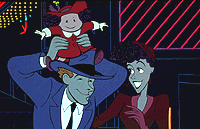
Eric showed Hirschfeld a version of "Rhapsody" that was fully animated
and about 60% in color on a visit to New York, shortly before the artist's
96th birthday. "I was really Mister Sweaty Palms," he recalls. "What if
he didn't like it?" Hirschfeld was delighted with the film; his wife Louise
called it "the best birthday present he ever could have gotten."
"I'm very pleased with what they did: it's a marvelous job," Hirschfeld
said in a recent telephone interview. "Eric seems to have understood what
I've tried to do in my drawings. Again, I'm very pleased with it, and I'm
anxious to see the finished film."
|
||||||||||||